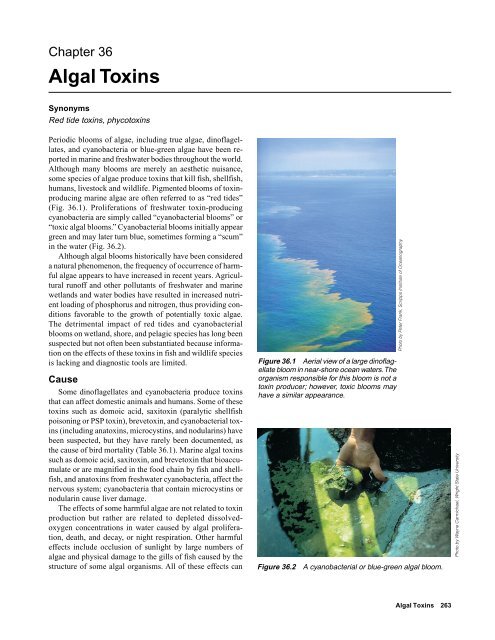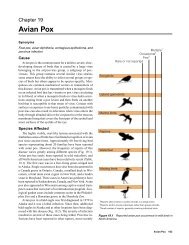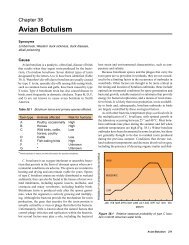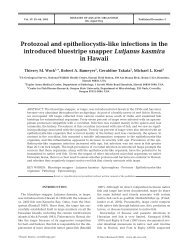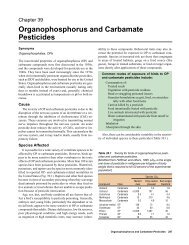Algal Toxins
Algal Toxins
Algal Toxins
You also want an ePaper? Increase the reach of your titles
YUMPU automatically turns print PDFs into web optimized ePapers that Google loves.
Chapter 36<br />
<strong>Algal</strong> <strong>Toxins</strong><br />
Synonyms<br />
Red tide toxins, phycotoxins<br />
Periodic blooms of algae, including true algae, dinoflagellates,<br />
and cyanobacteria or blue-green algae have been reported<br />
in marine and freshwater bodies throughout the world.<br />
Although many blooms are merely an aesthetic nuisance,<br />
some species of algae produce toxins that kill fish, shellfish,<br />
humans, livestock and wildlife. Pigmented blooms of toxinproducing<br />
marine algae are often referred to as “red tides”<br />
(Fig. 36.1). Proliferations of freshwater toxin-producing<br />
cyanobacteria are simply called “cyanobacterial blooms” or<br />
“toxic algal blooms.” Cyanobacterial blooms initially appear<br />
green and may later turn blue, sometimes forming a “scum”<br />
in the water (Fig. 36.2).<br />
Although algal blooms historically have been considered<br />
a natural phenomenon, the frequency of occurrence of harmful<br />
algae appears to have increased in recent years. Agricultural<br />
runoff and other pollutants of freshwater and marine<br />
wetlands and water bodies have resulted in increased nutrient<br />
loading of phosphorus and nitrogen, thus providing conditions<br />
favorable to the growth of potentially toxic algae.<br />
The detrimental impact of red tides and cyanobacterial<br />
blooms on wetland, shore, and pelagic species has long been<br />
suspected but not often been substantiated because information<br />
on the effects of these toxins in fish and wildlife species<br />
is lacking and diagnostic tools are limited.<br />
Cause<br />
Some dinoflagellates and cyanobacteria produce toxins<br />
that can affect domestic animals and humans. Some of these<br />
toxins such as domoic acid, saxitoxin (paralytic shellfish<br />
poisoning or PSP toxin), brevetoxin, and cyanobacterial toxins<br />
(including anatoxins, microcystins, and nodularins) have<br />
been suspected, but they have rarely been documented, as<br />
the cause of bird mortality (Table 36.1). Marine algal toxins<br />
such as domoic acid, saxitoxin, and brevetoxin that bioaccumulate<br />
or are magnified in the food chain by fish and shellfish,<br />
and anatoxins from freshwater cyanobacteria, affect the<br />
nervous system; cyanobacteria that contain microcystins or<br />
nodularin cause liver damage.<br />
The effects of some harmful algae are not related to toxin<br />
production but rather are related to depleted dissolvedoxygen<br />
concentrations in water caused by algal proliferation,<br />
death, and decay, or night respiration. Other harmful<br />
effects include occlusion of sunlight by large numbers of<br />
algae and physical damage to the gills of fish caused by the<br />
structure of some algal organisms. All of these effects can<br />
Figure 36.1 Aerial view of a large dinoflagellate<br />
bloom in near-shore ocean waters. The<br />
organism responsible for this bloom is not a<br />
toxin producer; however, toxic blooms may<br />
have a similar appearance.<br />
Figure 36.2<br />
A cyanobacterial or blue-green algal bloom.<br />
Photo by Peter Frank, Scripps Institute of Oceanography<br />
Photo by Wayne Carmichael, Wright State University<br />
<strong>Algal</strong> <strong>Toxins</strong> 263
Table 36.1<br />
Documented instances of wild bird mortality caused by algal toxins.<br />
Migratory bird<br />
Route of<br />
Toxin <strong>Algal</strong> species Toxin type(s) species affected exposure<br />
Cyanobacterial Microcystis sp., Hepatotoxins Unidentified ducks, Oral<br />
Anabaena sp., (microcystins geese, and songbirds, (water)<br />
Aphanizomenon sp., and nodularin) Franklin’s gull, American<br />
Nodularia sp., Neurotoxins coot, mallard, American<br />
and (anatoxin-a and wigeon<br />
Oscillatoria sp. anatoxin-a(s))<br />
Domoic acid Pseudonitzschia sp. Neurotoxin Brown pelican, Oral<br />
(amnesic shellfish Brandt’s cormorant (food items)<br />
poisoning)<br />
Saxitoxin Alexandrium sp. Neurotoxin Shag, northern fulmar, Oral<br />
(paralytic great cormorant, (food items)<br />
shellfish<br />
herring gull, common<br />
poisoning)<br />
tern, common murre,<br />
Pacific loon, and sooty<br />
shearwater<br />
Brevetoxin Gymnodinium sp. Neurotoxin Lesser scaup Oral<br />
(food items)<br />
lead to mortality of aquatic invertebrates, aquatic plants, or<br />
fish and may produce an environment conducive to botulism.<br />
Other marine algal toxins (okadaic acid, neosaxitoxin,<br />
ciguatoxin, and Pfiesteria exotoxin) and cyanobacterial toxins<br />
(saxitoxin, neosaxitoxin, and cylindrospermopsin) have<br />
not yet been identified as causes of bird mortality events, but<br />
increased awareness and further research may establish a<br />
relationship.<br />
Species Affected<br />
Many bird and mammal species can be affected by algal<br />
toxins. Most reports of mortality in birds are of die-offs that<br />
occur in conjunction with a bloom. Sometimes algal toxins<br />
are found in potential food items; however, there have been<br />
very few instances in which the algal toxin has been isolated<br />
from the ingesta or tissues of affected birds. Domoic acid<br />
poisoning caused mortality in brown pelicans and Brandt’s<br />
cormorants on the central California coast. Brevetoxin has<br />
been suspected as the cause of mortality in lesser scaup, and<br />
saxitoxin has been strongly suspected as the cause of mortality<br />
in sea birds (common terns, shags, great cormorants,<br />
northern fulmars, herring gulls, common murres, Pacific<br />
loons, sooty shearwaters, and others). Cyanobacterial toxicosis<br />
has been suspected in mortalities of free-ranging ducks,<br />
geese, eared grebes, gulls, and songbirds.<br />
Distribution<br />
Many of the organisms responsible for red tides are widely<br />
distributed and, in recent years, the organisms seem to be<br />
markedly spreading. Natural events such as hurricanes can<br />
disperse organisms, and it is suspected that some organisms<br />
may be transported long distances in ship ballast waters. Another<br />
factor that may encourage algal proliferation in both<br />
marine and freshwater systems is increased nutrient loading.<br />
Certain algae occur more commonly in some areas than<br />
others and it is useful to know which ones are problems in<br />
specific locations. Good sources of information about algal<br />
blooms are the State public health department or the State<br />
division of marine resources or marine fisheries.<br />
264 Field Manual of Wildlife Diseases: Birds
Seasonality<br />
There have not been enough confirmed instances of wild<br />
bird mortality caused by red tides and cyanobacterial blooms<br />
to establish seasonal patterns of occurrence.<br />
Field Signs<br />
Field signs reported are variable and they depend on the<br />
toxin involved. Domoic acid poisoning of brown pelicans<br />
caused neurologic signs that included muscle tremors, a characteristic<br />
side-to-side head movement, pouch scratching,<br />
awkward flight, toe clenching, twisting of the head over the<br />
back, vomiting, and loss of the righting reflex just before<br />
death. Brandt’s cormorants that also were involved in this<br />
mortality event were easily approached and handled, but they<br />
did not exhibit the neurologic signs seen in the pelicans. Sea<br />
birds suspected of having been poisoned by saxitoxin exhibited<br />
paralysis and vomiting. Clinical signs observed in lesser<br />
scaup suspected of having been poisoned by brevetoxin included<br />
lethargy, weakness, reluctance or inability to fly, head<br />
droop, and excessive ocular, nasal, and oral discharge.<br />
White Pekin ducklings that were experimentally exposed<br />
to brevetoxins exhibited lethargy, loss of muscle coordination<br />
or ataxia, spastic head movements, head droop to one<br />
side, and leg extension to the rear during rest. Clinical signs<br />
in muscovy ducks dosed with anatoxin-a(s) included excessive<br />
salivation, regurgitation of algae, diarrhea, tremors, reduced<br />
responsiveness and activity, incoordination, difficulty<br />
breathing, excessive thirst, congestion in foot webs, wing<br />
and leg weakness, and recumbency and intermittent seizures<br />
prior to death.<br />
Gross Lesions<br />
No characteristic or diagnostic gross lesions have been<br />
described for most types of algal toxin poisonings of wild<br />
birds. Many of the toxins, particularly the neurotoxins, have<br />
a chemical effect that does not produce a grossly observable<br />
lesion. Birds that ingest toxic blooms of Microcystis may<br />
have notable lesions of necrosis or tissue death and hemorrhage<br />
in the liver. These lesions have been reported in domestic<br />
mammals and birds, including ducks, that died as a<br />
result of exposure to a toxic Microcystis algal bloom or that<br />
were experimentally dosed with microcystin.<br />
Diagnosis<br />
Definitive diagnosis of algal toxicosis is difficult. Circumstantial<br />
evidence, such as the occurrence of a marine red tide<br />
or freshwater cyanobacterial bloom in conjunction with a<br />
die-off, and supportive clinical and pathologic findings, such<br />
as a lack of evidence of the presence of other types of toxins<br />
or infectious disease, are often used to reach a presumptive<br />
diagnosis. Analysis of the upper gastrointestinal tract contents<br />
or tissues of affected birds for algal toxins is possible<br />
but the tests are not yet widely available. In addition, there<br />
are no established toxic thresholds for wildlife species. Even<br />
when levels of particular toxins can be measured it may be<br />
difficult to assess their significance. Recently developed<br />
methods permit detection of microcystins in animal tissues<br />
and gastrointestinal contents by using enzyme linked immunosorbent<br />
assay (ELISA) technologies. Also, it is now possible<br />
to detect saxitoxin in urine and blood samples from<br />
affected animals by using highly sensitive neuroreceptor assays.<br />
A sample of organisms from the bloom may be useful or<br />
necessary for diagnosis. Because of the ephemeral nature of<br />
blooms, collect algal samples during the die-off event as soon<br />
as possible after carcasses are found. Contact a diagnostic<br />
laboratory for advice on appropriate sample collection.<br />
A<br />
B<br />
Photos by JoAnn Burkholder, North Carolina State University<br />
Figure 36.3 (A and B) These fish were killed by Pfiesteria sp., an organism that has caused neurological problems, including<br />
prolonged amnesia, in people exposed by aerosols in a laboratory. This organism has only been fully described recently, and it<br />
has not been reported to cause mortality in birds; however, it may be encountered by biologists investigating concurrent bird and<br />
fish kills.<br />
<strong>Algal</strong> <strong>Toxins</strong> 265
Control<br />
Because it is difficult to identify algal toxins as the cause<br />
of wildlife mortalities, there has been little opportunity to<br />
consider control measures. Currently, there is much interest<br />
in algal toxins and their threat to human water and food supplies.<br />
Identification of the conditions that trigger harmful algal<br />
blooms may aid in developing strategies to prevent red tides<br />
or freshwater cyanobacterial blooms and associated wildlife<br />
mortality. Controlling nutrient loading through reduced fertilizer<br />
use, improved animal waste control, and improved<br />
sewage treatment may reduce the number, or likely locations,<br />
of toxic algal blooms. Careful monitoring and early detection<br />
of potentially toxic algal blooms could allow time to<br />
initiate actions to prevent or reduce bird mortality.<br />
Human Health Considerations<br />
Most red tide and toxic freshwater cyanobacteria are not<br />
harmful unless they are ingested. However, some organisms<br />
irritate the skin and others release toxic compounds into the<br />
water and, if aerosolized by wave action, these compounds<br />
may cause problems when people inhale them (Fig. 36.3).<br />
When investigating wildlife mortality that is occurring in conjunction<br />
with a known red tide or cyanobacterial bloom, contact<br />
the local public health department or a diagnostic laboratory<br />
for information on precautions you may need to take.<br />
As in the investigation of all wildlife mortality events, wear<br />
rubber or latex gloves when handling carcasses.<br />
Lynn H. Creekmore<br />
Supplementary Reading<br />
Anderson, D.A., 1994, Red tides: Scientific American, August,<br />
p. 62–68.<br />
_____, 1994, The toxins of cyanobacteria: Scientific American,<br />
January, p. 78–86.<br />
Forrester, D.J., Gaskin, J.M., White, F.H., Thompson, N.P., Quick,<br />
J.A., Jr., Henderson, G.E., Woodard, J.C., and Robertson,<br />
W.D., 1977, An epizootic of waterfowl associated with a red<br />
tide episode in Florida: Journal of Wildlife Diseases, v. 13,<br />
p. 160–167.<br />
Nisbet, I.C.T., 1983, Paralytic shellfish poisoning: Effects on<br />
breeding terns; Condor, v. 85, p. 338–345.<br />
Work, T.M., Barr, B., Beale, A. M., Quilliam, M.A., and Wright,<br />
J.L.C., 1993, Epidemiology of domoic acid poisoning in brown<br />
pelicans (Pelecanus occidentalis) and Brandt’s cormorants<br />
(Phalacrocorax penicillatus) in California: Journal of Zoo and<br />
Wildlife Medicine, v. 24, p. 54–62.<br />
266 Field Manual of Wildlife Diseases: Birds


